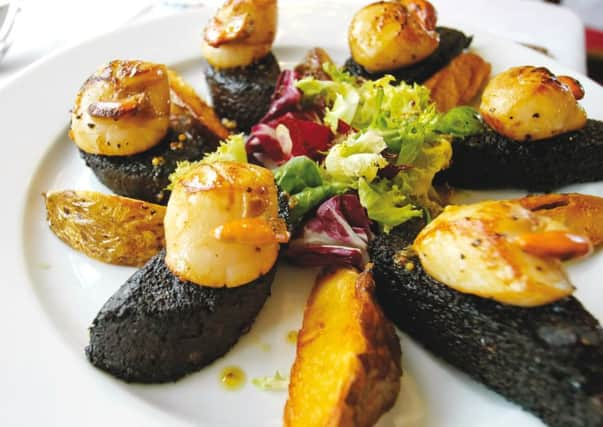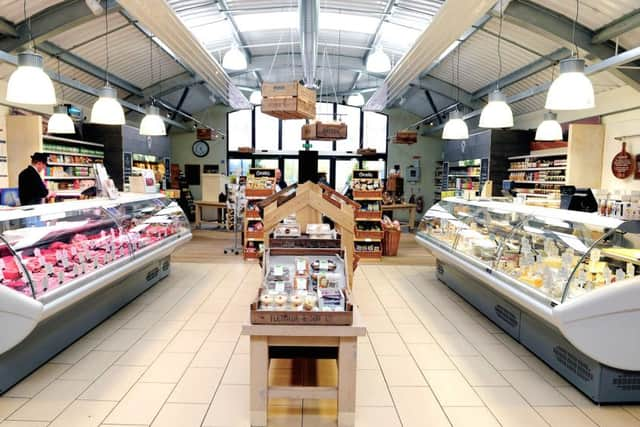Food story key to sector's success


Home to historic staples such as porridge, single malt and shortbread as well as more modern concoctions – haggis pakora and clootie samosas spring to mind – the story behind Scotland’s food and drink is its USP.
In the last decade our reputation for fine food has blossomed with industry turnover up 44 per cent since 2007 to more than £14 billion and the aim now is to continue that growth by doubling that number to £30bn by 2030.
Advertisement
Hide AdAdvertisement
Hide AdIn March the vision for the Scottish food and drink brand was published in a strategy document called Ambition 2030 by the Scotland Food & Drink Partnership, an industry-led partnership of the main organisations in the farming, fishing, food and drink sector, alongside the Scottish Government and its key agencies.


Scotland certainly isn’t the only country vying for the title of “food and drink nation”; France prides itself on its culinary offering with world-class chefs, sommeliers and passionate waiting staff; Italy has mastered the art of marketing its specialities from fresh pasta, to cured meats and charcuterie, and truffles from Tuscany.
But according to James Withers, chief executive of Scotland Food & Drink, there is one thing that sets Scottish produce apart.
“What we now have is a national identity of food and drink in Scotland,” says Withers.
“It is a brand that has developed at home and overseas and as well as established businesses we have a whole new generation of entrepreneurial new-starts.


“It is an incredibly competitive market. Every country I have been to believes they have the best food and drink in the world and they are all hugely ambitious.
“I think we have the best story to tell. We have our quality products like Scotch beef, soft fruit, our salmon, and Scotch whisky which is iconic as a product globally, but it is the broader story that sits around it that is important. Scotland should be massively confident about going out and competing against anyone.”
There are Protected Geographical Indications (PGIs) such as Arbroath Smokies which stand out for the unique method and location in which they are made, but that degree of specialism does come with limitations.
Advertisement
Hide AdAdvertisement
Hide AdThe haddock is gutted at sea, washed, boxed and sent to auction at the fish market. What then sets them apart is they are dry salted, tied in pairs by the tails and smoked over a pit which is dug into the ground and set with a half whisky barrel, where a hardwood fire of beech and oak is lit.
For producers operating at this level, mass production will never be an option. “One thing Scotland won’t compete on is mass volume and low cost,” says Withers.
Food tourism is a relatively untapped market but as the partners in Ambition 2030 and individual producers work to raise the industry’s profile, the number of visitors travelling to Scotland for its unique food and drink offering is expected to rise and we need to be ready for them.
Businesses need to have strategies in place to promote the story behind their product and connect what’s in the packet or bottle back to the land it came from.
Using water from a nearby spring or stream sells, as does the romance of a family business in the Highlands, passed down through the generations.
“Scotland is a phenomenal tourist destination and the two things we know that visitors to Scotland will do is require accommodation and consume food and drink,” says Withers.
“One of the fastest growing areas of the tourism industry is food tourism; people want to try local food and drink.
“If 15m people are going to visit Scotland this year, we need to look at how we ensure they are getting the full food and drink experience.”
Advertisement
Hide AdAdvertisement
Hide AdAccording to VisitScotland’s visitor survey for 2015/2016, a gap still exists between expectations and experience of the quality of food in Scotland, particularly for international visitors, and tourists still rate availability of local produce and value for money of eating out lower than other aspects of their holiday experience.
That said, the sector has come on in leaps and bounds compared to ten years ago when Scotland Food & Drink was established in order to drive collaborative working and grow the industry.
“Ten years ago food and drink was a pretty static sector and few people would have seen it as key to the Scottish economy,” says Withers.
“Now food and drink is the fastest-growing export in Scotland.
“In a world where people are increasingly interested in the quality and provenance of their food and drink, Scotland has as good an opportunity as any country in the world to achieve a leading food and drink sector and to grow.”
Since 2007 exports have risen by 56 per cent to almost £5.5bn and the Scottish manufacturing growth rate is twice the UK average for food and drink. Now it’s a case of keeping up that momentum and continuing to champion food and drink as one of Scotland’s specialities.
“Ambition 2030 makes no secret about being hugely ambitious,” says Withers.
“We are looking at how we really make a mark over the next ten to 15 years and make food and drink a star player in Scotland’s economy.”
Advertisement
Hide AdAdvertisement
Hide AdBrexit and the constitutional future of the UK will inevitably come hand in hand with challenges but having already come so far, Withers, as the voice of Scotland’s food and drink sector, is remaining optimistic about the opportunities change might present.
“Whatever happens with Brexit or Scottish independence, if we are a strong brand and we innovate and invest in our people we will be in a good place and we will be more resilient.”
With so much of the conversation focused around exports and tapping into new markets overseas, it is easy to forget the work that still needs to be done closer to home.
“If we take diet and nutrition as an example, we have one of the most naturally healthy larders on Earth but a population that, by most measurements, has been getting more unhealthy as the years have gone on,” says Withers.
Companies now are looking at reformulating recipes to include less fat or less sugar, working collaboratively with food scientists at some of Scotland’s leading research institutions including Abertay’s Food Innovation Centre in Dundee and Queen Margaret University’s Centre for Food Development & Innovation near Edinburgh.
Free-from food and drink has been another growth area for Scotland. Genius gluten-free bread, which is produced in Edinburgh, hit supermarket shelves back in 2009 and has since added bagels, cupcakes, sausage rolls, pies and more to its range.
The capital is also home to the UK’s first dedicated gluten-free microbrewery.
Bellfield Brewery was set up in Abbeyhill in 2016 by two coeliacs who believed there should be more options for those with certain dietary requirements.
Advertisement
Hide AdAdvertisement
Hide AdIn Dunbar, there’s NoCowKnowHow which makes cakes and bakes without preservatives, dairy, lactose, eggs and nuts, while Lazy Days Foods in Harthill, North Lanarkshire, is run by a pair of food scientists specialising in treats for consumers with a range of food allergies.
It’s not just about what we eat but where we eat it and while the Far East in particular is a major importer of Scottish seafood and Scotch whisky, the London market remains ripe for promoting Scottish produce.
“There is much more work to be done in getting more Scottish companies operating south of the border,” says Withers.
“How do we get companies that are selling in 60 supermarkets in Scotland selling in 600 supermarkets across the UK?
“The London market is twice the size of the whole of the Scottish market and has a really premium food offering.
“That market development will be a big, big part of what we will do over the next while.”
Consumer habits are changing and keeping up with those trends and demands is something of an uphill battle.
Producers need, as far as possible, to be one step ahead of what their customers are looking for.
Advertisement
Hide AdAdvertisement
Hide Ad“The way we buy food and drink and consumer behaviour is changing at an incredible rate of knots,” says Withers.
There are the two and four-wheeled takeaway giants Deliveroo and UberEats which are bringing restaurant food to diners at home.
Farm shops are broadening their offering with night markets that cater to the Monday to Friday, nine-to-five crowd, and give them access to the fresh, organic produce that has become so popular.
Then, there’s the craft gin craze which has yet to show any signs of slowing, and even Amazon is getting in on the action by offering online grocery shopping.
“We need to understand that modern consumer and how they are changing on a day-to-day basis,” says Withers.
Responsibility and sustainability have become crucial to the success of many businesses.
Everybody wants to cuts costs and reduce waste, and that ties in with what the consumer is looking for in terms of buying from a business that cares.
It is a key part of Ambition 2030’s vision for the Scottish food and drink brand, with the strategy document stating: “We will develop our brand values around responsibility and trust.
Advertisement
Hide AdAdvertisement
Hide Ad“This goes much deeper than marketing – it’s about rewarding commitment to, and defining a culture around our stewardship of the environment and resource management, our investment in the workforce and our ability and willingness to contribute to the wellbeing of our nation.”
Withers explains: “In terms of looking at the future consumer, people want to buy products from companies and countries that have a broader impact.
“People want to work in industries that have a broader impact than just profit. Our view is that we need to have a broader impact on the community around us and on the health and wellbeing of Scotland as well.”